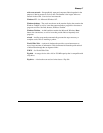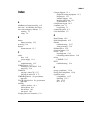
Glossary-15
server – A specially configured computer running network software that provides
access to network resources for client workstation computers.
shortcut – An icon on the Windows desktop that provides a direct link to a
program, directory, or file. Shortcuts are identifiable by the small arrow located in
the lower left corner of the icon image.
Sleep mode – A low power consumption state that components of the computer
enter after a predetermined amount of time.
software – Programs that contain computer operation instructions. There are two
types of software; application software and system software. See application,
operating system.
Super Video Graphics Adapter (SVGA) – A video card that typically supports
resolutions of 1024 x 728 pixels with over 65,000 colors. See pixel.
surf – To browse or navigate through the information on the Internet and the
World Wide Web.
surge protector – A device that protects electrical devices from brief bursts of
excessive voltage.
SVGA – See Super Video Graphics Array.
system board – The main circuit board inside a computer. Also known as
motherboard.
taskbar –See Windows Taskbar.
TCP/IP – See Transmission Control Protocol/Internet Protocol.
touchpad – A small, touch-sensitive pad used as a pointing device on some
portable computers. By tracing a finger or other object along the pad, you can
move the pointer on the display screen. You select a menu option by tapping on the
pad (if this feature is enabled).
Transmission Control Protocol/Internet Protocol (TCP/IP) – An industry
standard instruction set that specifies how data is transmitted through a network.
TCP/IP enables cross-platform communications, that is, a computer running a
Microsoft Windows operating system can access data and information provided by
a computer running a different operating system. Every computer and network that
is connected to the Internet uses TCP/IP.
uninterruptible power supply (UPS) – A device that provides surge protection
and, in the event of a power failure, short-term battery backup power.


















